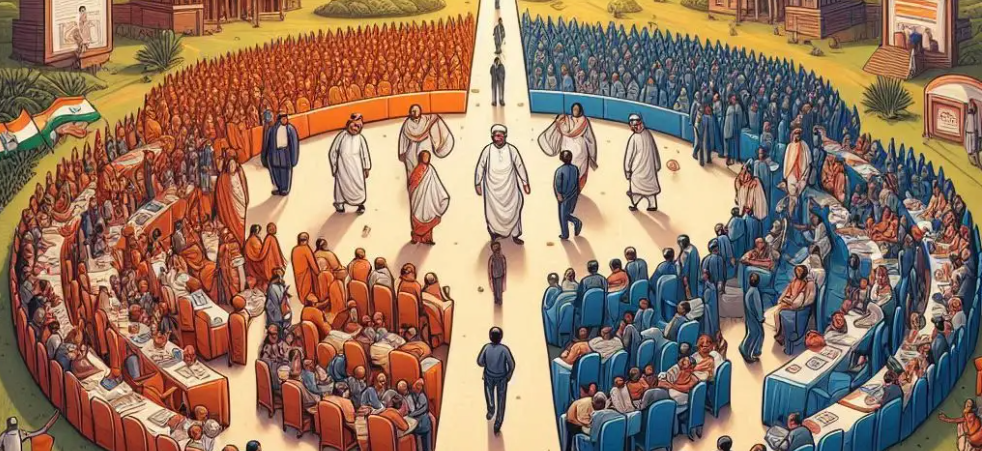Mahatma Gandhi represenls the middle path approach in India Politics. Give logical explanation
Mahatma Gandhi, also known as the
“Father of the Nation,” is one of the most important figures in Indian history.
He led India’s struggle for independence through non-violence and truth. But
more than just a freedom fighter, Gandhi was also a thinker, philosopher, and
political leader. One of the most important ideas in Gandhi’s political thought
is the “Middle Path.”
The middle path approach means
avoiding extremes. It means choosing a balanced, peaceful, and practical way
between two opposite sides. Gandhi applied this idea in his politics. He
believed in non-violence but also believed in action. He supported freedom but
with responsibility. This article will explain how Gandhi’s approach to
politics followed the middle path and why this idea is still important in
Indian politics today.
What is the Middle Path?
The concept of the middle path comes
from ancient Indian and Buddhist philosophy. In Buddhism, it means avoiding the
extremes of too much pleasure and too much suffering. It teaches balance,
moderation, and wisdom.
Gandhi adapted this idea to
politics. For him, the middle path meant:
- Avoiding violence but not accepting injustice
- Balancing tradition with modern ideas
- Working with both the rich and the poor
- Supporting reforms without destroying values
- Staying spiritual without mixing religion in politics
Now let us look at how Gandhi used
the middle path in different areas of Indian politics.
Non-Violence
but Not Weakness
Gandhi’s most famous idea was Ahimsa
or non-violence. He always said that India’s fight for freedom should be
through peaceful means. He believed that violence brings hatred, fear, and
destruction. But this does not mean he accepted injustice or slavery.
Gandhi encouraged people to fight
injustice with courage, but through peaceful protest, non-cooperation, and
civil disobedience. He led movements like:
- Non-Cooperation Movement (1920)
- Salt March (1930)
- Quit India Movement (1942)
In all these movements, Gandhi asked
people not to attack the British but to refuse to obey unjust laws
peacefully.
This was a middle path not accepting British rule, but not using
weapons to remove it. It inspired the world and showed that real strength comes
from truth and non-violence.
Tradition
and Modernity
Gandhi loved Indian culture, values,
and traditions. He wore khadi, supported village life, and believed in simple
living. At the same time, he was open to new ideas, technology, and science but only if they helped people live better
lives.
He did not blindly copy the West or
reject it. He said:
“I do not want my house to be walled
in on all sides and my windows to be stuffed. I want the cultures of all the
lands to be blown about my house as freely as possible. But I refuse to be
blown off my feet by any.”
This means Gandhi wanted to keep the
Indian identity alive while also learning from the world again a middle path.
Working
with the Rich and the Poor
Gandhi was deeply concerned about
poverty and inequality. He wanted to remove untouchability, support farmers,
and help the poor live with dignity. But he did not hate the rich. Instead, he
believed in trusteeship that
rich people should use their wealth for the welfare of society.
Gandhi said:
“Wealth should not be owned for
selfish use but held in trust for the benefit of all.”
He did not support communism which
believes in taking wealth by force, nor did he support capitalism that allows
unlimited profit. He chose a middle path cooperation between classes, moral use of
wealth, and social justice through love and understanding.
Reforms Without Breaking the System
Gandhi wanted change in society, but
through gradual, peaceful reform, not violent revolution. He fought
against untouchability, injustice to women, and caste discrimination. But he
never called for the destruction of Hinduism or Indian society.
He believed in reform from within.
For example:
- He supported Harijan (Dalit) upliftment but did
not want to break the Hindu religion.
- He promoted women’s rights but also respected
the role of women in the family.
- He supported education for all, but one that
includes moral values and practical skills, not just bookish knowledge.
This shows that Gandhi’s way was
balanced bring change without
destroying what is good in the old system.
Religion
and Politics – Not Mixing, but Morally Connected
Gandhi was a deeply religious man.
But he believed in Sarva Dharma Sambhav (equal respect for all
religions). He said politics should not be controlled by any one religion, but
should follow moral and spiritual values.
He never supported Hindu Rashtra or
any religious rule. Instead, he worked with people of all religions Hindus, Muslims, Sikhs, Christians and believed India belonged to all.
This again shows a middle path spiritual politics, not religious
politics.
Freedom
with Responsibility
Gandhi wanted freedom for India, but
he also warned that freedom must come with responsibility. He said:
“Real freedom means the ability to
do the right thing, not just the ability to do anything.”
He believed that self-rule
(Swaraj) means not just throwing out the British, but Indians becoming
responsible, self-disciplined, and morally strong. His idea of Gram Swaraj
or village self-government showed that democracy starts from the bottom.
This approach avoids both the
extremes of dictatorship and disorder. It promotes a mature democracy a balanced middle path.
Unity
in Diversity
India is a land of great diversity different religions, languages, castes, and
cultures. Gandhi believed in unity in diversity. He respected all
differences and encouraged dialogue and cooperation.
He said:
“Our ability to reach unity in
diversity will be the beauty and the test of our civilization.”
He avoided both the dangers of
majoritarianism and separatism. He stood for inclusive nationalism where everyone feels they belong.
The Middle Path in Today’s Politics
Gandhi’s middle path is still very
relevant today. In modern politics, we often see extreme views violence, hate speech, corruption, and
communalism. Many politicians try to divide people to win votes.
If we follow Gandhi’s path, we can
build a better India:
- Peaceful protests, not violence
- Cooperation between rich and poor
- Respect for all religions
- Clean and moral politics
- Balanced economic growth
- Protecting both tradition and modern values
His ideas of non-violence, truth,
simplicity, and service can guide us even in today’s complicated world.
Mahatma Gandhi was not just a political
leader. He was a moral guide. His politics was not about power but about service,
love, and balance. He showed that real leadership means choosing the middle
path the path of peace, justice, and harmony.
He avoided the extremes of violence
and fear, of pride and hatred, of selfishness and greed. His path was hard, but
it was the right one.
As India moves forward, we must
remember Gandhi’s message. Only by following the middle path can we create a
country that is not only free but also fair, peaceful, and united.








.jpg)

EmoticonEmoticon